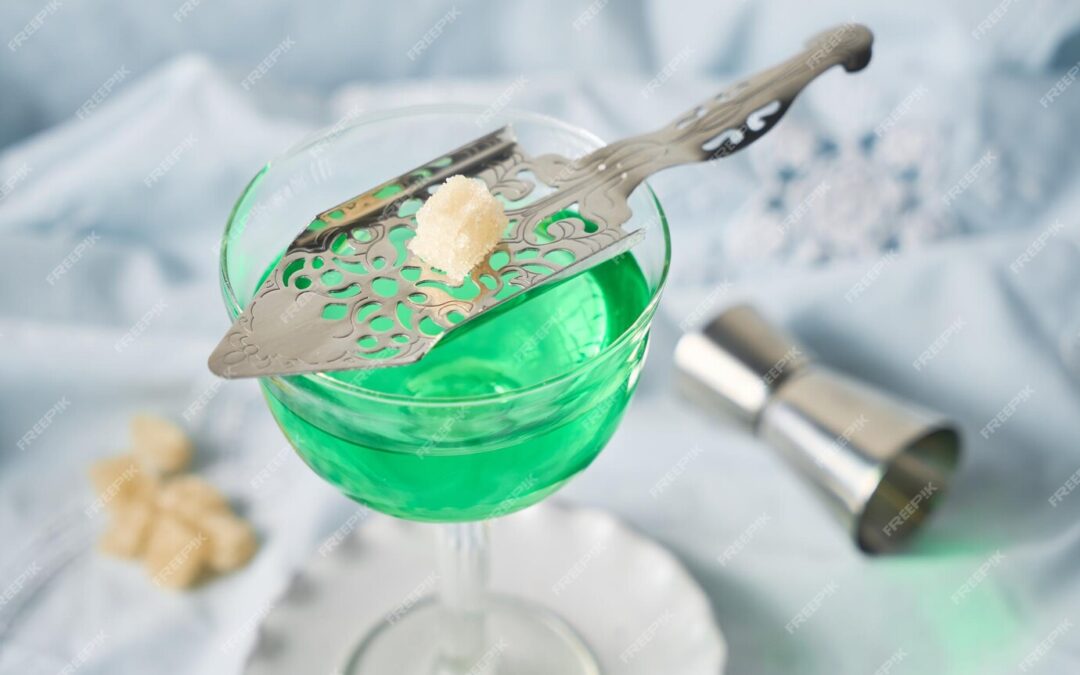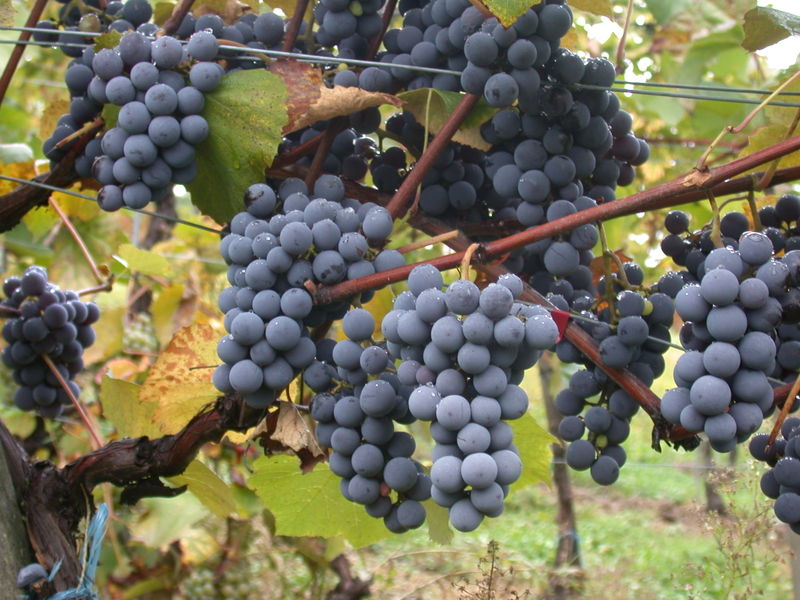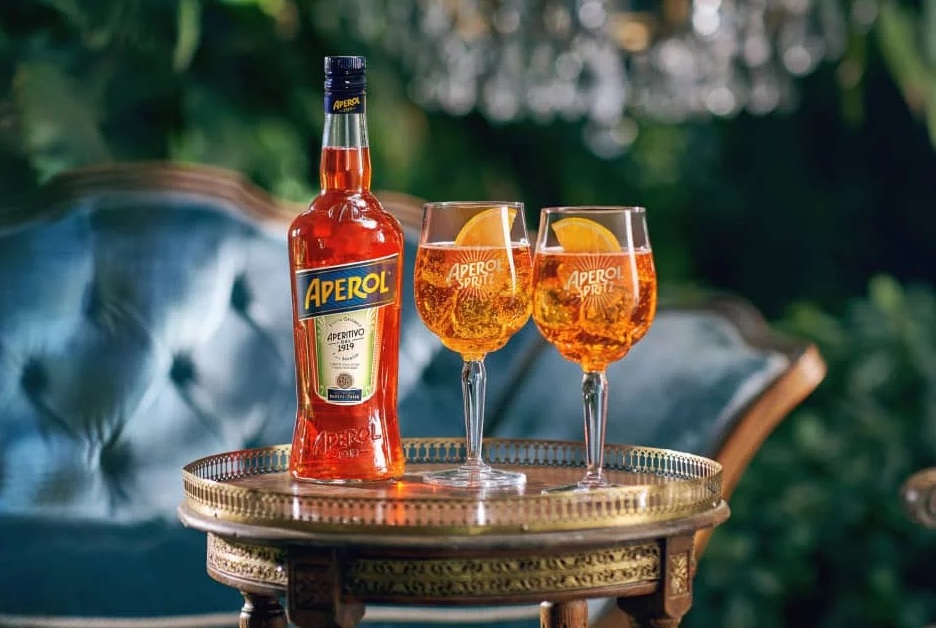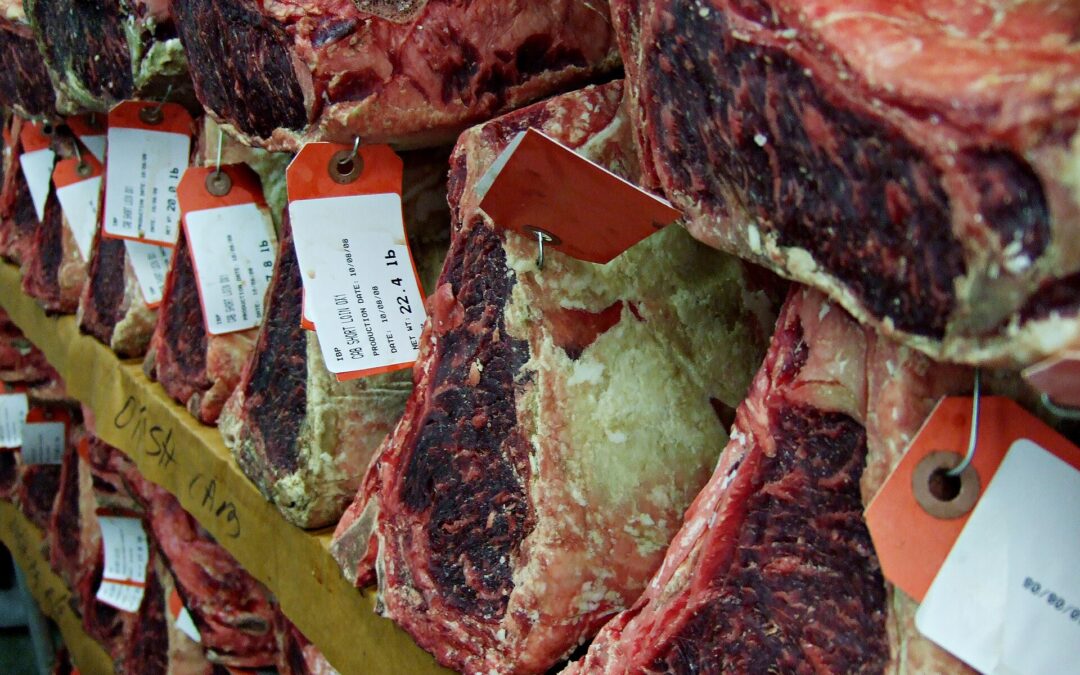
by Ross Kingsley | Feb 2, 2025 | LIQUORS: LIFT YOUR SPIRITS
Absinthe is a potent, emerald-hued spirit with a rich history steeped in mystery and controversy. This iconic drink, often called “The Green Fairy” and known for its high alcohol content, has fascinated drinkers for centuries.
Origins and Early History
Absinthe traces its origins to Switzerland in the late 18th century, where it was first created as a medicinal elixir. Dr. Pierre Ordinaire is often credited with popularizing the formula, blending grand wormwood (Artemisia Absinthium), anise, fennel, and other herbs. By the early 19th century, it had gained popularity in France, particularly among soldiers returning from Algeria, who appreciated its purported health benefits and refreshing taste. Absinthe soon became a cultural phenomenon, favored by artists and writers such as Vincent van Gogh, Ernest Hemingway, and Oscar Wilde.
Controversies and Bans
Absinthe’s rise to prominence was accompanied by intense scrutiny. Its high alcohol content, typically between 45% and 74%, combined with the presence of Thujone (a compound found in wormwood), led to claims that it caused hallucinations, insanity, and violent behavior. These concerns were fueled by a series of high-profile incidents, such as the infamous 1905 case in Switzerland where a man murdered his family after allegedly drinking Absinthe. Although he had consumed other alcohol, Absinthe was scapegoated, leading to widespread moral panic.
By the early 20th century, Absinthe was banned in many countries, including Switzerland (1910), the United States (1912), and France (1915). These bans, often driven by the temperance movement or competition from wine producers, were based more on public hysteria than scientific evidence.
Traditional Serving Methods
Absinthe is traditionally served by placing a sugar cube on a slotted spoon over a glass of the spirit. Ice-cold water is then slowly dripped onto the sugar, diluting the Absinthe and releasing its complex herbal aromas. This ritual, known as “Louching,” produces a cloudy, opalescent effect in the glass. A different method has the sugar is pre-soaked in alcohol, usually more absinthe, and then set ablaze. The flaming sugar cube is then dropped into the glass igniting the absinthe. This can add to the drama, but also become dangerous if done by amateurs.
Revival & Current Bans
Modern research has debunked the myth of Absinthe’s hallucinogenic properties, leading to its resurgence. Today, it is legal in most countries, though its Thujone content is regulated. Absinthe remains banned in some countries, including Algeria, Bahrain, and parts of the Middle East, due to its alcohol content or lingering misconceptions about its effects.
Despite its colorful and turbulent history, Absinthe continues to captivate drinkers with its mystique and cultural significance, serving as a testament to the enduring allure of “The Green Fairy.”
Image Credit: https://www.freepik.com
_ _ _
© CHURRASCO PHUKET STEAKHOUSE / ALL RIGHTS RESERVED
>>> Reprinting, reposting & sharing allowed, in exchange for a backlink and credits <<<
Churrasco Phuket Steakhouse serves affordable Wagyu and Black Angus steaks and burgers. We are open daily from 12noon to 11pm at Jungceylon Shopping Center in Patong / Phuket.
We are family-friendly and offer free parking and Wi-Fi for guests. See our menus, reserve your table, find our location, and check all reviews here:
https://ChurrascoPhuket.com/
#Churrascophuket #jungceylon #phuketsteakhouse #affordablewagyu #wagyu

by Ross Kingsley | Jan 26, 2025 | RESTAURANT BUSINESS: BEHIND THE KITCHEN DOOR
Restaurants are dynamic and volatile environments, where collaboration between the kitchen and service teams is essential. Yet, these two groups often experience friction due to their distinct roles and priorities. Understanding these differences—and addressing the tension they create—can foster a more cohesive and productive workplace.
Traditional Differences
-
Work Environment: Kitchens are high-pressure spaces focused on precision, timing, and execution. In contrast, the service team operates in a customer-facing environment, juggling hospitality and problem-solving.
-
Guest Interaction: A critical difference lies in how each team deals with customer feedback. Servers are directly confronted with complaints, bearing the brunt of guest frustrations, whether about food, delays, or errors. Kitchen staff, shielded from this interaction, may not grasp the emotional toll such exchanges take.
-
Blame Dynamics: Kitchen teams often attribute guest complaints to service errors, assuming that servers miscommunicated orders or mishandled requests. This tendency can create resentment within the service team, who may feel unsupported in their efforts to mediate between guests and the kitchen.
Mitigation and Prevention
-
Cross-Training: Having servers spend time in the kitchen and kitchen staff observe the floor during service helps build empathy and a clearer understanding of each team’s challenges.
-
Feedback Systems: Establish a structured feedback loop where complaints and compliments are shared with both teams. This ensures everyone understands the root causes and works together on solutions.
-
Clear Processes: Implement clear communication protocols, such as detailed order management systems, to minimize misunderstandings and mistakes.
-
Collaborative Culture: Managers should promote a culture of shared responsibility, emphasizing that both teams contribute equally to the guest experience.
-
Team-Building: Activities outside of work strengthen relationships and reduce the tendency to assign blame. Friends work together better than antagonists.
By addressing these traditional differences head-on, restaurants can cultivate a supportive environment where the kitchen and service teams work together seamlessly, enhancing the overall dining experience for the most important people around – the restaurant’s guests.
Image Credit: https://freepik.com
_ _ _
© CHURRASCO PHUKET STEAKHOUSE / ALL RIGHTS RESERVED
>>> Reprinting, reposting & sharing allowed, in exchange for a backlink and credits <<<
Churrasco Phuket Steakhouse serves affordable Wagyu and Black Angus steaks and burgers. We are open daily from 12noon to 11pm at Jungceylon Shopping Center in Patong / Phuket.
We are family-friendly and offer free parking and Wi-Fi for guests. See our menus, reserve your table, find our location, and check all reviews here:
https://ChurrascoPhuket.com/
#Churrascophuket #jungceylon #phuketsteakhouse #affordablewagyu #wagyu

by Ross Kingsley | Jan 26, 2025 | WINES: UNCORKING THE MYSTERY
Nestled in eastern France, just south of Burgundy, the Beaujolais wine region boasts a storied history and a unique identity in the world of viticulture. Known for its approachable wines, Beaujolais has cultivated a reputation that combines tradition and occasion.
Origins and History
The roots of Beaujolais wine trace back to Roman times, when vines were first planted in the area. By the Middle Ages, the region’s wines were already celebrated, particularly by monks who played a significant role in cultivating and expanding vineyards. During the 17th and 18th centuries, Beaujolais wines gained popularity in nearby Lyon and later found their way to Paris and beyond, cementing their place in French culture.
In the 20th century, Beaujolais solidified its identity with the introduction of Beaujolais Nouveau, a wine celebrated for its fresh, youthful character. This annual event has become a global phenomenon, showcasing the region’s winemaking and marketing prowess.
The Grapes of Beaujolais
The star of Beaujolais is the Gamay grape, a thin-skinned variety that thrives in the region’s granitic and clay-limestone soils. Known for its ability to produce fruity, aromatic wines, Gamay is the backbone of all Beaujolais styles, from the light and fresh Nouveau to the more structured and age-worthy Cru wines. Chardonnay, though less prominent, is also cultivated here, primarily for white wines.
The Beaujolais Nouveau System
Beaujolais Nouveau is perhaps the most famous product of the region, introduced to the world on the third Thursday of November each year. This wine is made using carbonic maceration, a fermentation technique that enhances its fruity and aromatic qualities. Designed for immediate consumption, Beaujolais Nouveau is a celebration of the recent harvest and has become a beloved global tradition.
Notable Winemakers and Crus
Beaujolais is divided into ten Crus, each offering a distinct expression of Gamay. These include Morgon, Fleurie, and Moulin-à-Vent, renowned for their complexity and aging potential. Esteemed winemakers such as Marcel Lapierre and Jean Foillard have gained recognition for elevating Beaujolais beyond its Nouveau fame.
Conclusion
From its ancient vineyards to the global spectacle of Beaujolais Nouveau, the region continues to captivate wine lovers with its vibrant flavors, versatility, and sense of celebration.
Image Credit: https://wikipedia.org
_ _ _
© CHURRASCO PHUKET STEAKHOUSE / ALL RIGHTS RESERVED
>>> Reprinting, reposting & sharing allowed, in exchange for a backlink and credits <<<
Churrasco Phuket Steakhouse serves affordable Wagyu and Black Angus steaks and burgers. We are open daily from 12noon to 11pm at Jungceylon Shopping Center in Patong / Phuket.
We are family-friendly and offer free parking and Wi-Fi for guests. See our menus, reserve your table, find our location, and check all reviews here:
https://ChurrascoPhuket.com/
#Churrascophuket #jungceylon #phuketsteakhouse #affordablewagyu #wagyu

by Ross Kingsley | Jan 19, 2025 | LIQUORS: LIFT YOUR SPIRITS
Aperol, with its vibrant orange hue and bittersweet taste, has become synonymous with Italian aperitivo culture. Originating in Padua, Italy, in 1919, Aperol was created by Luigi and Silvio Barbieri after seven years of experimentation. The brothers sought to craft a low-alcohol, versatile aperitif that would appeal to a broad audience. Their creation, boasting a still secret blend of herbs, roots, and oranges, was a departure from the stronger liqueurs of the time, offering a lighter, refreshing alternative.
Though popular in its early years, Aperol’s true renaissance came post-World War II as aperitivo culture flourished across Italy. Aperol found its perfect pairing in the Spritz, a simple cocktail blending Aperol, Prosecco, and soda water. While the Spritz originated in the Veneto region during the 19th century, Aperol’s inclusion added a bright and modern twist, catapulting the drink to global fame. The Aperol Spritz, served over ice with a slice of orange, has since become a quintessential symbol of leisure, embodying the Italian ethos of “la dolce vita.”
Adaptations of the Aperol Spritz have further cemented its versatility. The Aperol Wine Spritz offers a simplified and less sweet variation, swapping Prosecco for white wine and a dash of soda water, which tempers the sweetness while enhancing its citrus and herbal notes. This version is equally refreshing and perfect for those seeking a subtler sparkle in their aperitivo experience.
From its humble beginnings to becoming a global icon, Aperol’s journey reflects its adaptability and timeless appeal. Whether sipped at a bustling piazza in Rome or a rooftop bar in New York, Aperol invites a moment of relaxation, celebration, and connection, all with a signature orange glow.
Image Credit:
https://aperol.com
_ _ _
© CHURRASCO PHUKET STEAKHOUSE / ALL RIGHTS RESERVED
>>> Reprinting, reposting & sharing allowed, in exchange for a backlink and credits <<<
Churrasco Phuket Steakhouse serves affordable Wagyu and Black Angus steaks and burgers. We are open daily from 12noon to 11pm at Jungceylon Shopping Center in Patong / Phuket.
We are family-friendly and offer free parking and Wi-Fi for guests. See our menus, reserve your table, find our location, and check all reviews here:
https://ChurrascoPhuket.com/
#Churrascophuket #jungceylon #phuketsteakhouse #affordablewagyu #wagyu

by Ross Kingsley | Jan 19, 2025 | KNOWLEDGE: MEAT ESSENTIALS
Dry aging is a centuries-old technique used to enhance beef. The process involves storing large cuts of beef in a temperature- and humidity-controlled environment for several weeks, allowing “noble rot”, and for natural enzymes to break down muscle tissue to improve tenderness and intensifying the meat’s flavor.
Benefits of Dry Aging
The primary benefit of dry aging is “flavor development”. As the beef loses moisture over time, its flavors become more concentrated, resulting in a richer and nuttier taste that many connoisseurs describe as special. Additionally, the enzymatic breakdown of proteins enhances tenderness, creating a buttery texture. These qualities make dry-aged beef a luxurious choice for some steak lovers.
Risks and Dangers
Despite its benefits, dry aging comes with high risks. The process requires extremely precise control of temperature, constant humidity of 85%, and precise air circulation to prevent the growth of harmful bacteria and mold. Improper conditions lead to spoilage, food poisoning, and significant product loss. Moreover, as the beef dehydrates, it loses up to 30% of its weight, making it less cost-effective compared to other aging methods.
Dry Aging vs. Wet Aging
Dry aging is contrasted with wet aging, a more modern and cost-efficient method. Wet aging involves vacuum-sealing beef in plastic packaging, allowing it to tenderize in its own juices. Wet aging enhances tenderness and maintains weight. For restaurants and butchers, the choice between these methods often depends on their clientele’s preferences and willingness to pay a lot extra for a perceived “premium flavor”.
In Conclusion
Dry ageing is not a method employed at Churrasco Phuket Steakhouse. We instead focus on serving high-quality cuts of beef, always imported deep chilled, never frozen. The beef is then wet aged further in-house, and char-grilled to order when it is ready for use. Dry aging’s high cost, weight loss, and space requirements are considered counterproductive in a very busy steakhouse like Churrasco, which prioritizes consistency and accessibility for its diverse clientele.
By sourcing top-grade beef and preparing it with expert techniques, Churrasco Phuket delivers exceptional flavor and tenderness without the added complications of dry aging, ensuring every guest enjoys a world-class dining experience. Our excellent guest reviews on Google, Tripadvisor or Facebook are proof of the validity of our approach.
Image Credit:
https://en.wikipedia.org
_ _ _
© CHURRASCO PHUKET STEAKHOUSE / ALL RIGHTS RESERVED
>>> Reprinting, reposting & sharing allowed, in exchange for a backlink and credits <<<
Churrasco Phuket Steakhouse serves affordable Wagyu and Black Angus steaks and burgers. We are open daily from 12noon to 11pm at Jungceylon Shopping Center in Patong / Phuket.
We are family-friendly and offer free parking and Wi-Fi for guests. See our menus, reserve your table, find our location, and check all reviews here:
https://ChurrascoPhuket.com/
#Churrascophuket #jungceylon #phuketsteakhouse #affordablewagyu #wagyu





